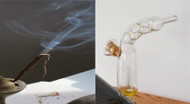Essential Oils or Incense?
Apr 21st 2021
Posted by Stephanie Chambers
by Stephanie Chambers
Incense has been burned for thousands of years in a wide variety of cultures. It is generally made from aromatic plant materials and sometimes Essential Oils are added. Burning incense and diffusing Essential Oils can create pleasant smells and both were originally designed to help with healing.*
The word “incense” comes from the Latin word “incendere” to burn, while in Sanskrit it is called “dhūpa” with the word “dhū” meaning to emit smoke. In terms of Ayurveda, incense ingredients may be categorized into five classes: ether (fruits like star Anise), water (stems and branches like Sandalwood), earth (roots like Turmeric), fire (flowers like Cloves), and air (leaves like Patchouli).*
The main difference between diffusing Essential Oils and burning incense is that when you burn incense smoke is produced. According to various researchers, incense smoke contains “gaseous pollutants, such as carbon monoxide (CO), nitrogen oxides (NOx), sulfur oxides (SOx), volatile organic compounds (VOCs), and absorbed toxic pollutants (polycyclic aromatic hydrocarbons and toxic metals). The solid particles range between ~10 and 500 nm.” When Essential Oils are diffused using heat, they also produce VOCs.*
There has been some positive research 1 which indicated that burning Frankincense (resin from the Boswellia plant) activates ion channels in the brain to alleviate anxiety or depression. However, this was burning a pure natural substance. Most incense you buy is a combination of a wide variety of substances. The way in which incense is created varies greatly. It may not be made the same way as it was originally supposed to be made, according to Ayurveda. So, the therapeutic results may vary.*
In ancient times, technology only allowed for things to be diffused via the potpourri or candle method. Nowadays, aromas don’t have to be breathed as part of carbon-laden smoke or diffused using heat, which distorts the scent and creates residues or oxidation. Instead, they can be inhaled in their pure form. Especially with recent advances in nebulizing diffusers, like those made by Amrita Aromatherapy, the Essential Oil droplets are much finer and thus more available to the body.*
Because the oil particles are so fine, they remain in suspension in the air for a long period of time rather than condensing and being absorbed by your carpet or other surroundings; so with Amrita’s nebulizers you end up using less Essential Oil than you would with another type of nebulizer. Amrita also has a professional nebulizer that turns on and off, thus overcoming the problem of the body habituating to a smell and not noticing it. Incense may still play a part in terms of religious ceremonies and other rituals, but now aromas can be experienced more fully and thus therapeutically using advances in diffusion technology such as nebulizers.*
Sources:
1. http://www.fasebj.org/content/22/8/3024.abstract
Disclaimer: The statements made in this blog have not been evaluated by the U.S. Food and Drug Administration (FDA). They are not intended to diagnose, cure or prevent any disease. If a condition persists, please contact your physician or healthcare provider. The information provided is not a substitute for a face-to-face consultation with a healthcare provider, and should not be construed as medical advice.
Original Published: 2015-09-16 / Last Modified: 2025-5-28

